Field Monitoring and Analysis of the Vibration of Stay Cables under Typhoon Conditions
Abstract
1. Introduction
2. Case Study
3. Wavelet-Matrix Transform
3.1. Daubechies Wavelet and Mallat Matrix
3.2. Multiscale Decomposition of the Wavelet Matrix
3.3. Extraction of the Nonstationary Wind Model
4. Field Measurements and Wind Characteristics
4.1. Turbulence Intensity
4.2. Gust Factor
4.3. Turbulence Power Spectral Density
5. Buffeting Response Analysis of the Cables Based on the Measured Data
5.1. The RMS Value of the Measured Cable Acceleration Response
5.2. Spectral Analysis of the Cable’s Measured Acceleration Response
5.3. Wavelet Packet Energy Analysis of the Cable’s Measured Acceleration Response
6. Conclusions
- The turbulence intensity in the nonstationary model is smaller than that in the stationary model, and the safety factor of the stationary model is higher, which is relatively conservative. In the engineering application, the stationary model can be used for design reference.
- The two fitting models proposed in this study can well describe the stationary and nonstationary relationships between the gust factor and turbulence intensity. The stationary model proposed in this study is similar to the He model, and the nonstationary model proposed in this study is similar to the Cao model.
- In the low frequency part, the power spectral density values of the stationary model were smaller than the Kaimal spectrum, while the power spectral density values of the nonstationary model were consistent with the Kaimal spectrum. It shows that the nonstationary model is more suitable for wind spectrum estimation.
- The measured vibration characteristics of the upstream and downstream cables have obvious regularity. The in-plane vibration or out of plane vibration of the same cable is very similar, and the out of plane vibration is greater than the in-plane vibration, which shows that the damper has a good effect on suppressing the in-plane vibration.
- The energy distribution in and out of the cable plane are different between the typhoon period and the normal climate condition wind period. It is mainly concentrated in the first frequency band (0–3.125 Hz) and the 11th frequency band (31.25–34.375 Hz); so, we should pay special attention to the high-order, vortex-induced vibration of the cables during a typhoon.
Author Contributions
Funding
Conflicts of Interest
References
- Guo, J. Key technical innovation of Xihoumen Bridge—The longest steel box gird suspension bridge in the world. Eng. Sci. 2010, 8, 18–22, CNKI:SUN:ENSC.0.2010-04-004. [Google Scholar]
- Xu, Y.L.; Zhu, L.D. Buffeting response of long-span cable-supported bridges under skew winds. Part 2: Case study. J. Sound. Vib. 2005, 281, 675–697. [Google Scholar] [CrossRef]
- Ni, Y.Q.; Wang, X.Y.; Chen, Z.Q.; Ko, J.M. Field observations of rain-wind-induced cable vibration in cable-stayed Dongting Lake Bridge. J. Wind Eng. Ind. Aerodyn. 2007, 95, 303–328. [Google Scholar] [CrossRef]
- Liu, M.; Liao, H.L.; Li, M.S.; Ma, C.M.; Yu, M. Long-term field measurement and analysis of the natural wind characteristics at the site of Xi-hou-men Bridge. J. Zhejiang Univ. Sci. A 2012, 13, 197–207. [Google Scholar] [CrossRef]
- Guo, Z.W.; Yuan, H.; Wang, X.S. Field measurement of non-stationary characteristics at site of Qingcaobei Yangtze River Bridge in Three Gorges. J. Build. Struct. 2019, 40, 11–18. [Google Scholar] [CrossRef]
- Wang, H.; Wu, T.; Tao, T.Y.; Li, A.Q.; Kareem, A. Measurements and analysis of non-stationary wind characteristics at Sutong Bridge in Typhoon Damrey. J. Wind Eng. Ind. Aerodyn. 2016, 151, 100–106. [Google Scholar] [CrossRef]
- Fenerci, A.; Oiseth, O. Strong wind characteristics and dynamic response of a long-span suspension bridge during a storm. J. Wind Eng. Ind. Aerodyn. 2018, 172, 116–138. [Google Scholar] [CrossRef]
- Davenport, A.G. The spectrum of horizontal gustiness near the ground in high wind. Q. J. R. Meteorol. Soc. 1961, 87, 194–211. [Google Scholar] [CrossRef]
- Kaimal, J.C.; Wyngaard, J.C.; Izumi, Y.; Cote, O.R. Spectral characteristics of surface layer turbulence. Q. J. R. Meteorol. Soc. 1972, 98, 563–589. [Google Scholar] [CrossRef]
- Panofsky, H.A.; Singer, I.A. Vertical structure of turbulence. Q. J. R. Meteorol. Soc. 1965, 91, 339–344. [Google Scholar] [CrossRef]
- Harris, R.I. Some further thoughts on the spectrum of gustiness in strong winds. J. Wind Eng. Ind. Aerodyn. 1990, 33, 461–477. [Google Scholar] [CrossRef]
- Shiotani, M.; Iwatani, Y. Horizontal Space Correlations of Velocity Fluctuations during Strong Winds. J. Meteor. Soc. Jpn. 1976, 54, 59–67. [Google Scholar] [CrossRef]
- Architectural Institute of Japan. Recommendations for Loads on Buildings; Architectural Institute of Japan: Tokyo, Japan, 2004. [Google Scholar]
- Professional Standard PRC. Wind-Resistant Design Specification for Highway Bridges; China Communications Press: Beijing, China, 2004. [Google Scholar]
- American Society of Civil Engineering. Minimum Design Loads for Buildings and Other Structures; ASCE 7-10: Reston, VA, USA, 2010. [Google Scholar]
- Su, Y.W.; Huang, G.Q.; Xu, Y.L. Derivation of time-varying mean for non-stationary downburst winds. J. Wind Eng. Ind. Aerodyn. 2015, 141, 39–48. [Google Scholar] [CrossRef]
- He, X.H.; Qin, H.X.; Tao, T.Y.; Liu, W.S.; Wang, H. Measurement of Non-Stationary Characteristics of a Landfall Typhoon at the Jiangyin Bridge Site. Sensors 2017, 17, 2186. [Google Scholar] [CrossRef] [PubMed]
- Chen, J.; Hui, M.C.H.; Xu, Y.L. A comparative study of stationary and non-stationary wind models using field measurements. Bound.-Lay. Meteorol. 2007, 122, 105–121. [Google Scholar] [CrossRef]
- Failla, G.; Pappatico, M.; Cundari, G.A. A wavelet-based spectrum for non-stationary processes. Mech. Res. Commun. 2011, 38, 361–367. [Google Scholar] [CrossRef]
- Xu, Y.L.; Chen, J. Characterizing nonstationary wind speed using empirical mode decomposition. ASCE J. Struct. Eng. 2004, 130, 912–920. [Google Scholar] [CrossRef]
- Tao, T.Y.; Wang, H.; Wu, T. Comparative Study of the Wind Characteristics of a Strong Wind Event Based on Stationary and Nonstationary Models. ASCE J. Struct. Eng. 2017, 143, 04016230. [Google Scholar] [CrossRef]
- Huang, G.Q.; Chen, X.Z. Wavelets-based estimation of multivariate evolutionary spectra and its application to nonstationary downburst winds. Eng. Struct. 2009, 31, 976–989. [Google Scholar] [CrossRef]
- Xiang, Z.G.; Lu, Y.L. An effective wavelet matrix transform approach for efficient solutions of electromagnetic integral equations. IEEE. Trans. Antenn. Propag. 1997, 45, 1205–1213. [Google Scholar] [CrossRef]
- Muralidharan, K.; Mishra, S.K.; Frantziskonis, G.; Deymier, P.A.; Nukala, P.; Simunovic, S.; Pannala, S. Dynamic compound wavelet matrix method for multiphysics and multiscale problems. Phys. Rev. E. 2008, 77, 026714. [Google Scholar] [CrossRef] [PubMed]
- Zhang, X.J. The improvement of orthogonality of Daubechies wavelet by wavelet matrix. Jiangxi Electr. Power 2013, 4, 56–59. [Google Scholar] [CrossRef]
- Cao, S.Y.; Tamura, Y.; Kikuchi, N.; Saito, M.; Nakayama, I.; Matsuzaki, Y. A case study of gust factor of a strong typhoon. J. Wind Eng. Ind. Aerodyn. 2015, 138, 52–60. [Google Scholar] [CrossRef]
- Yan, L.; Ren, L.; He, X.; Lu, S.; Guo, H.; Wu, T. Strong Wind Characteristics and Buffeting Response of a Cable-Stayed Bridge under Construction. Sensors 2020, 20, 1228. [Google Scholar] [CrossRef]
- Ishizaki, H. Wind profiles, turbulence intensities and gust factors for design in typhoon-prone regions. J. Wind Eng. Ind. Aerodyn. 1983, 13, 55–66. [Google Scholar] [CrossRef]
- Choi, E.C.C. Gradient height and velocity profile during typhoons. J. Wind Eng. Ind. Aerodyn. 1983, 13, 31–41. [Google Scholar] [CrossRef]
- Cao, S.Y.; Tamura, Y.; Kikuchi, N.; Saito, M.; Nakayama, I.; Matsuzaki, Y. Wind characteristics of a strong typhoon. J. Wind Eng. Ind. Aerodyn. 2009, 97, 11–21. [Google Scholar] [CrossRef]
- Matsumoto, M.; Saitoh, T.; Kitazawa, M.; Shirato, H.; Nishizaki, T. Response characteristics of rain-wind induced vibration of stay-cables of cable-stayed bridges. J. Wind Eng. Ind. Aerodyn. 1995, 57, 323–333. [Google Scholar] [CrossRef]
- Guo, J.; Hang, D.; Zhu, X.J. Prediction of crack propagation in U-rib components based on the Markov chain. ASCE J. Bridge. Eng. 2020. Accepted. [Google Scholar] [CrossRef]
- Yi, T.H.; Li, H.N.; Gu, M. Wavelet based multi-step filtering method for bridge health monitoring using GPS and accelerometer. Smart Struct. Syst. 2013, 11, 331–348. [Google Scholar] [CrossRef]
- Meo, M.; Zumpano, G.; Meng, X.L.; Cosser, E.; Roberts, G.; Dodson, A. Measurements of dynamic properties of a medium span suspension bridge by using the wavelet transforms. Mech. Syst. Signal Process. 2006, 20, 1112–1133. [Google Scholar] [CrossRef]

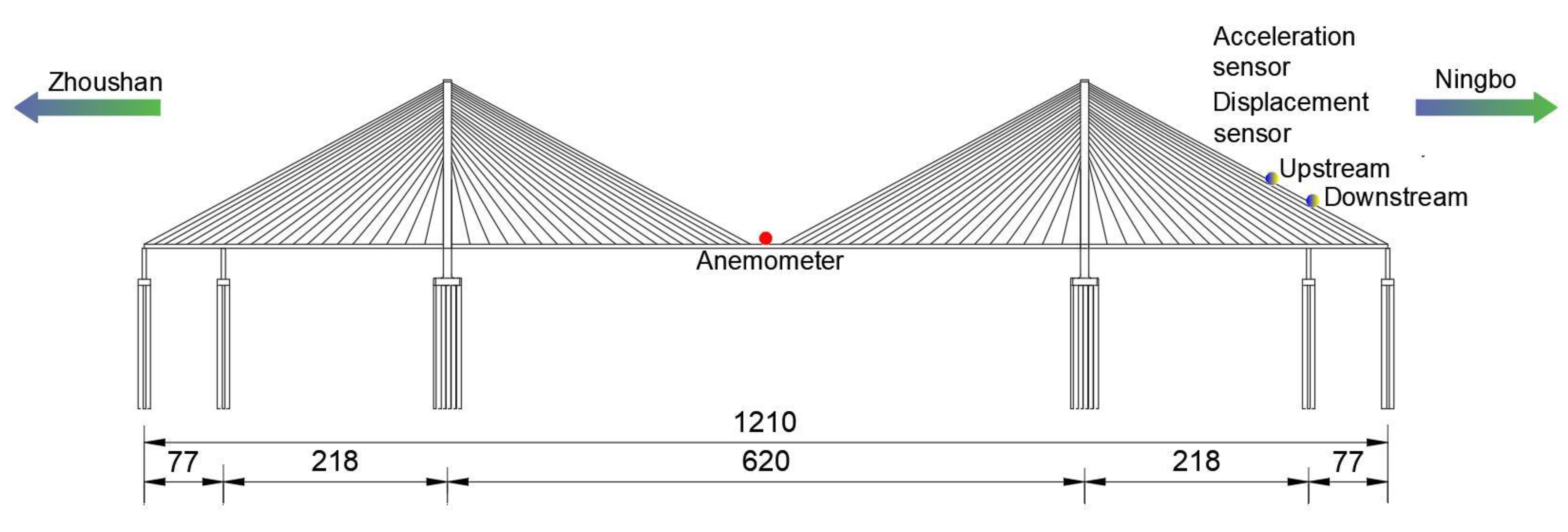
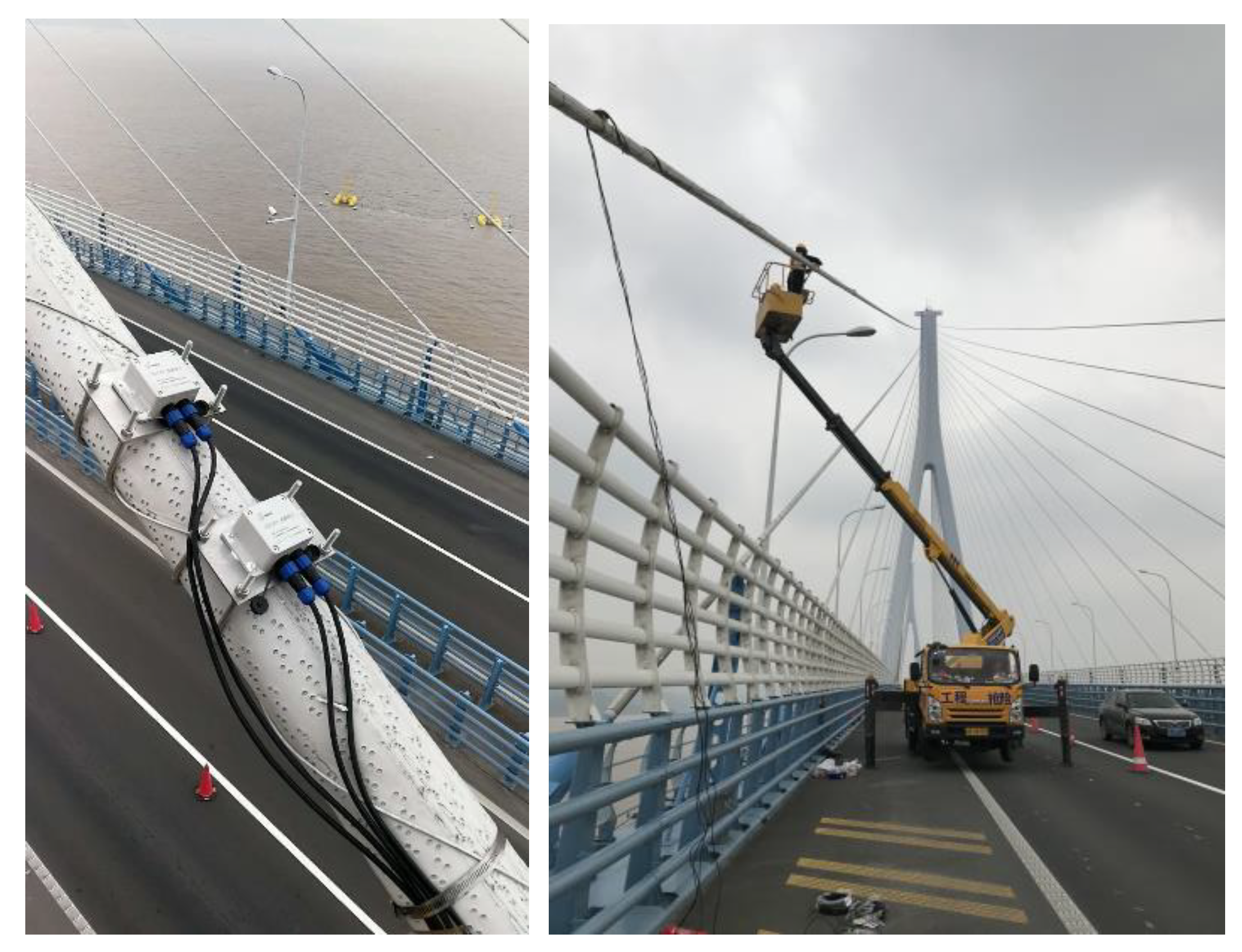

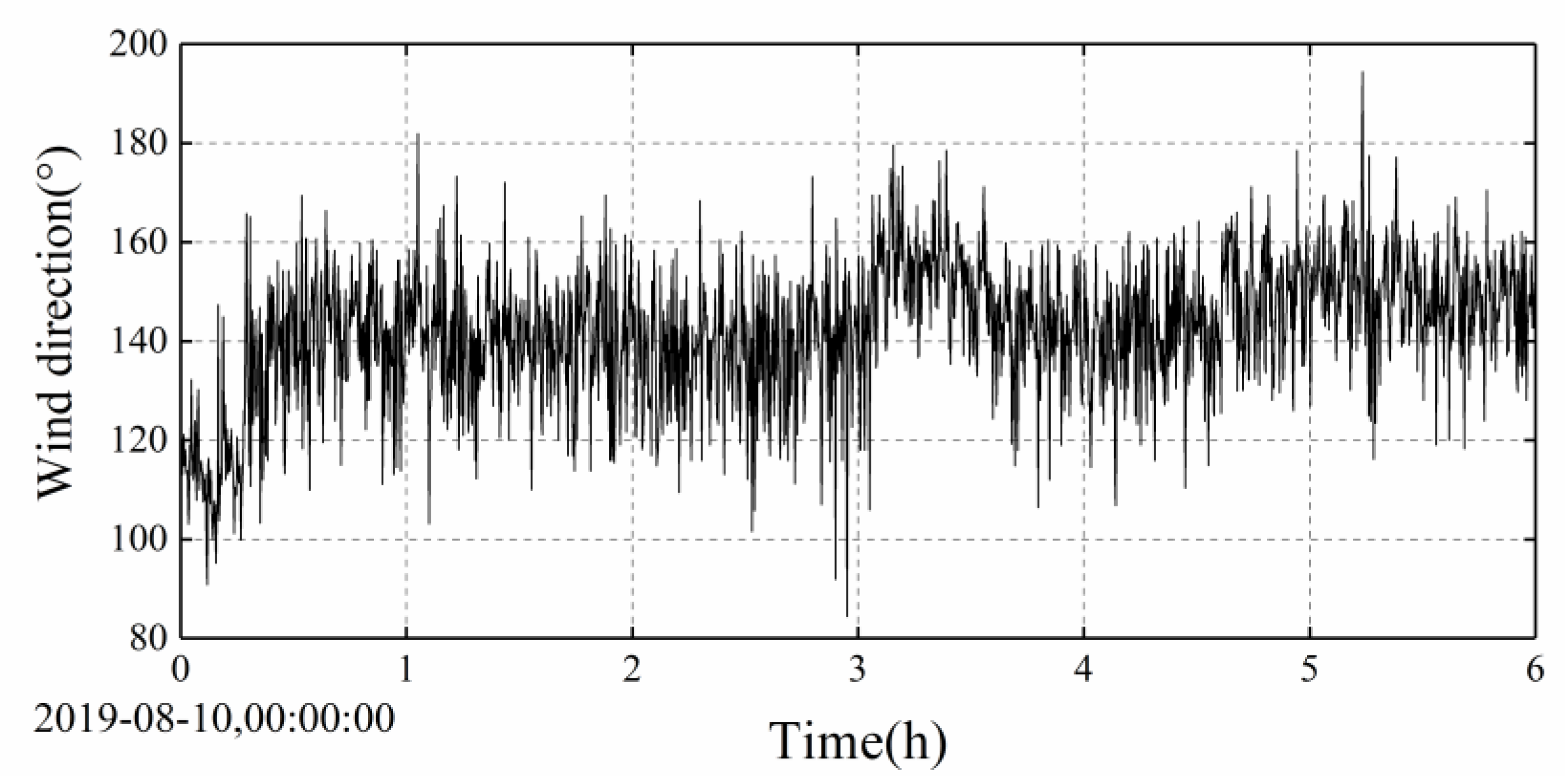




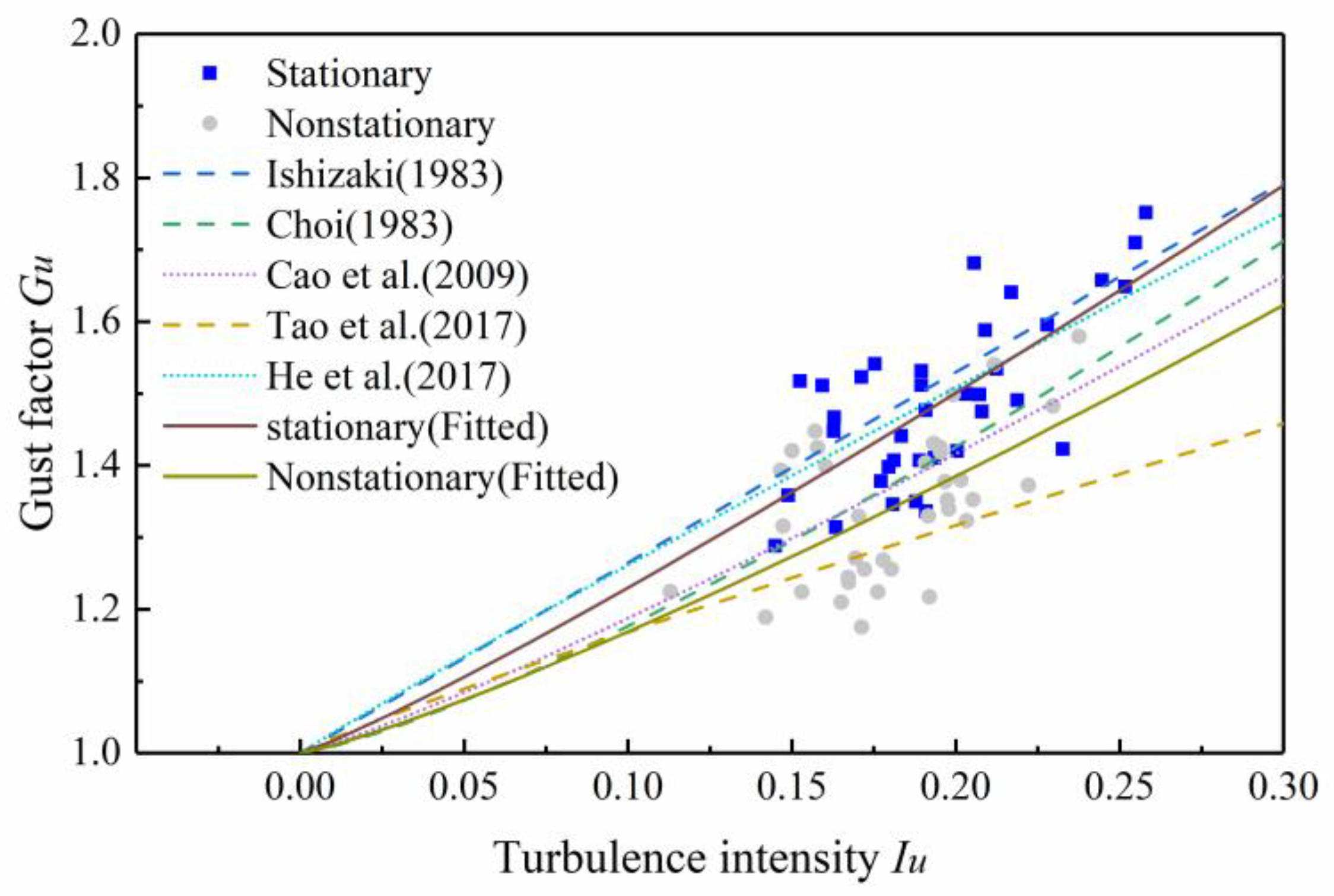

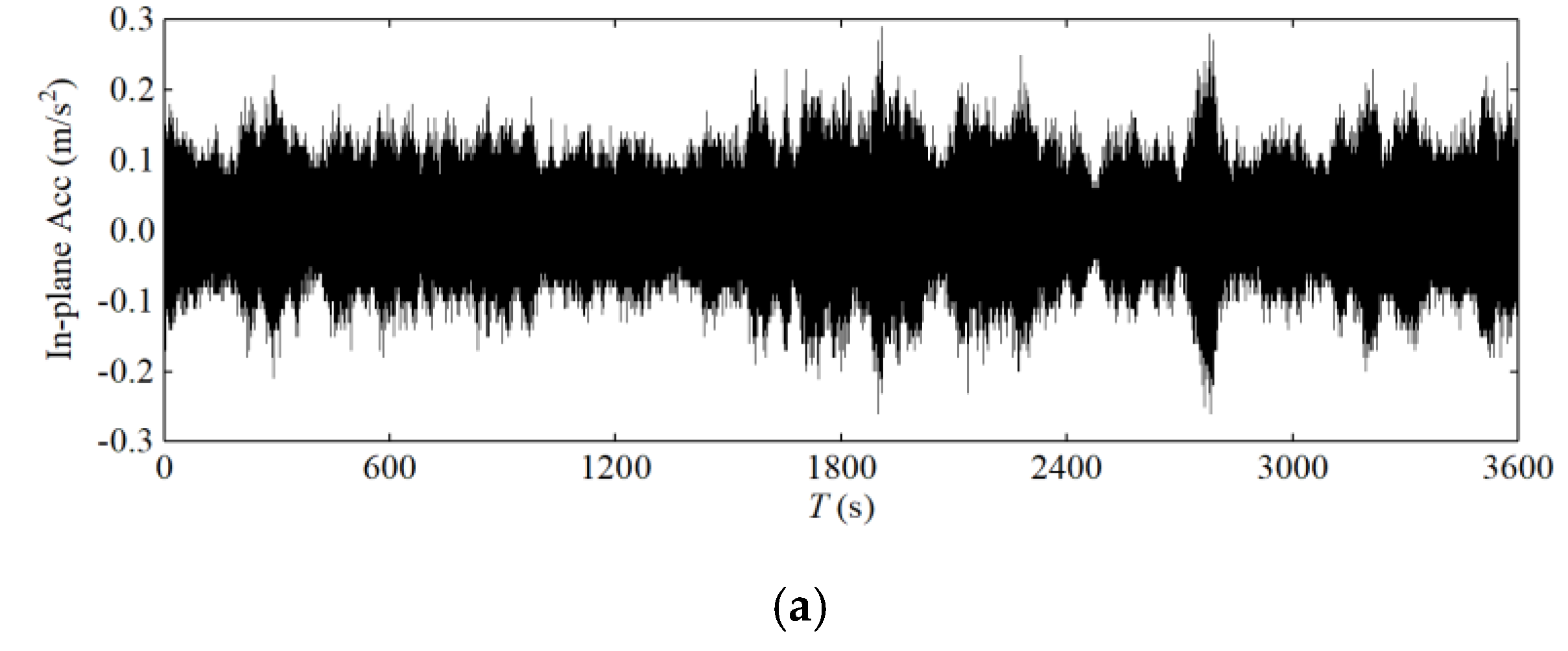
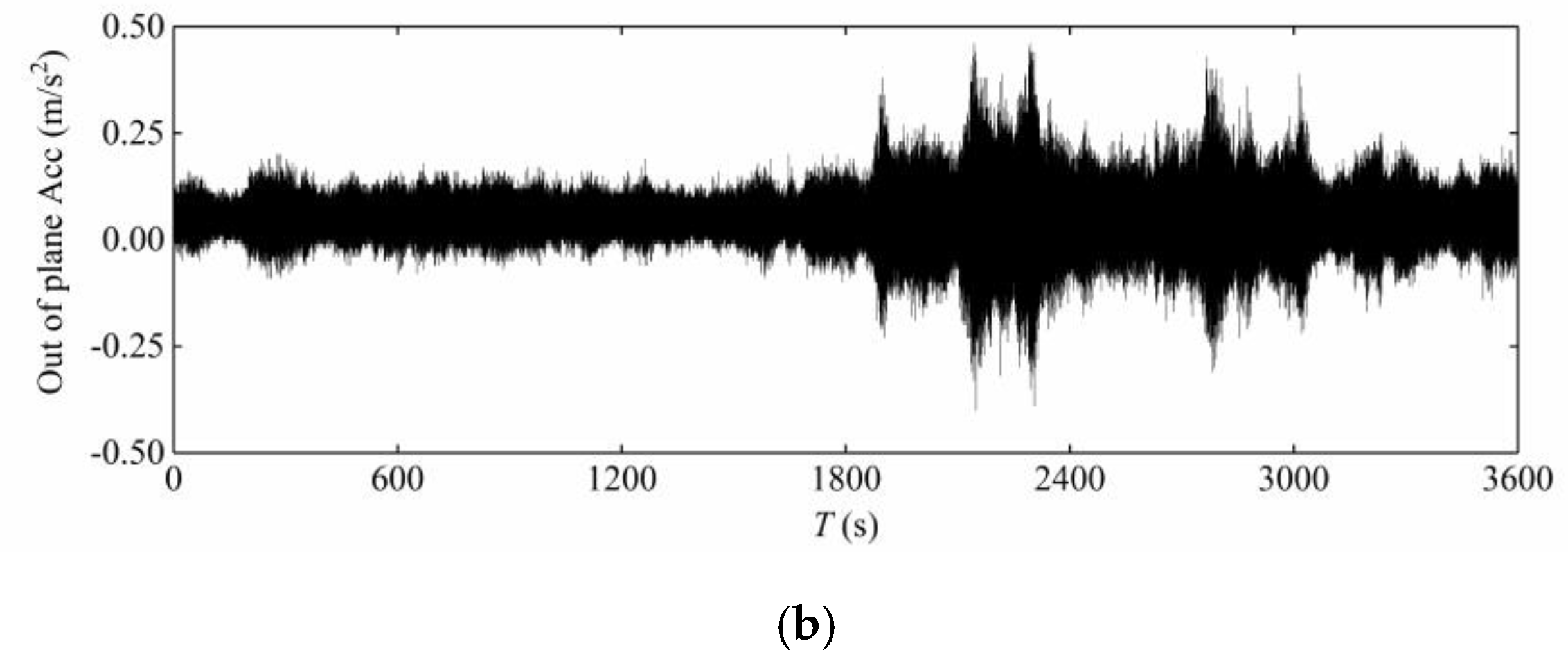

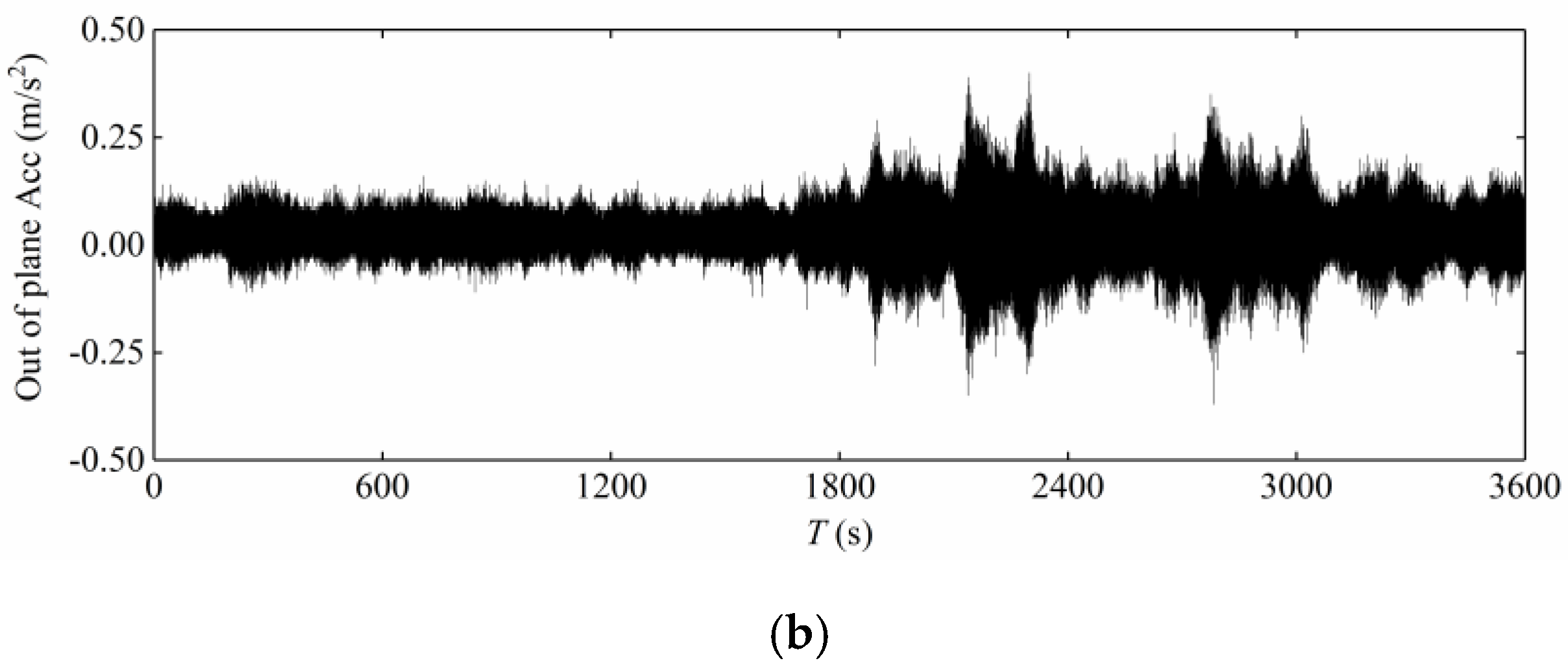




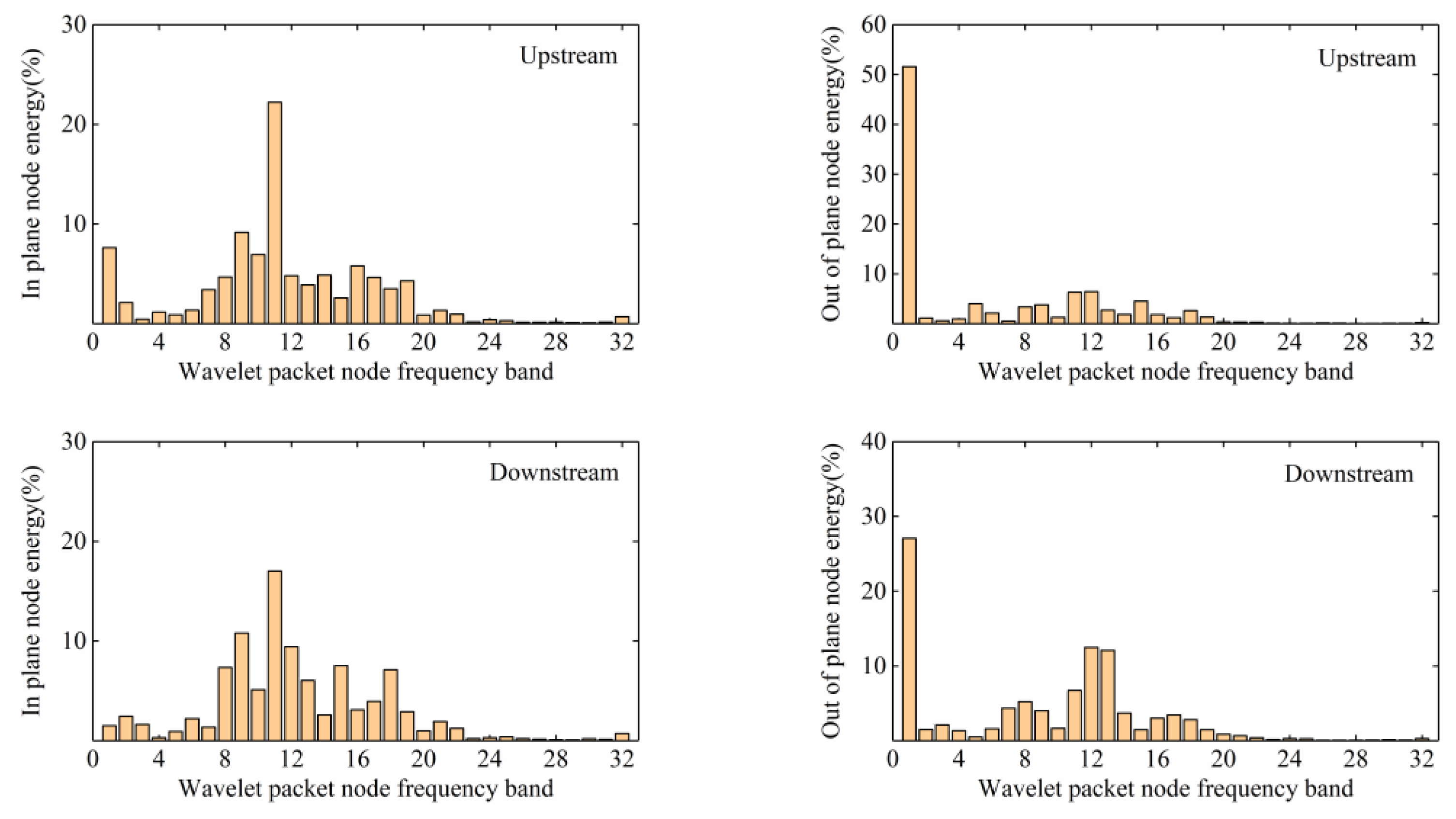
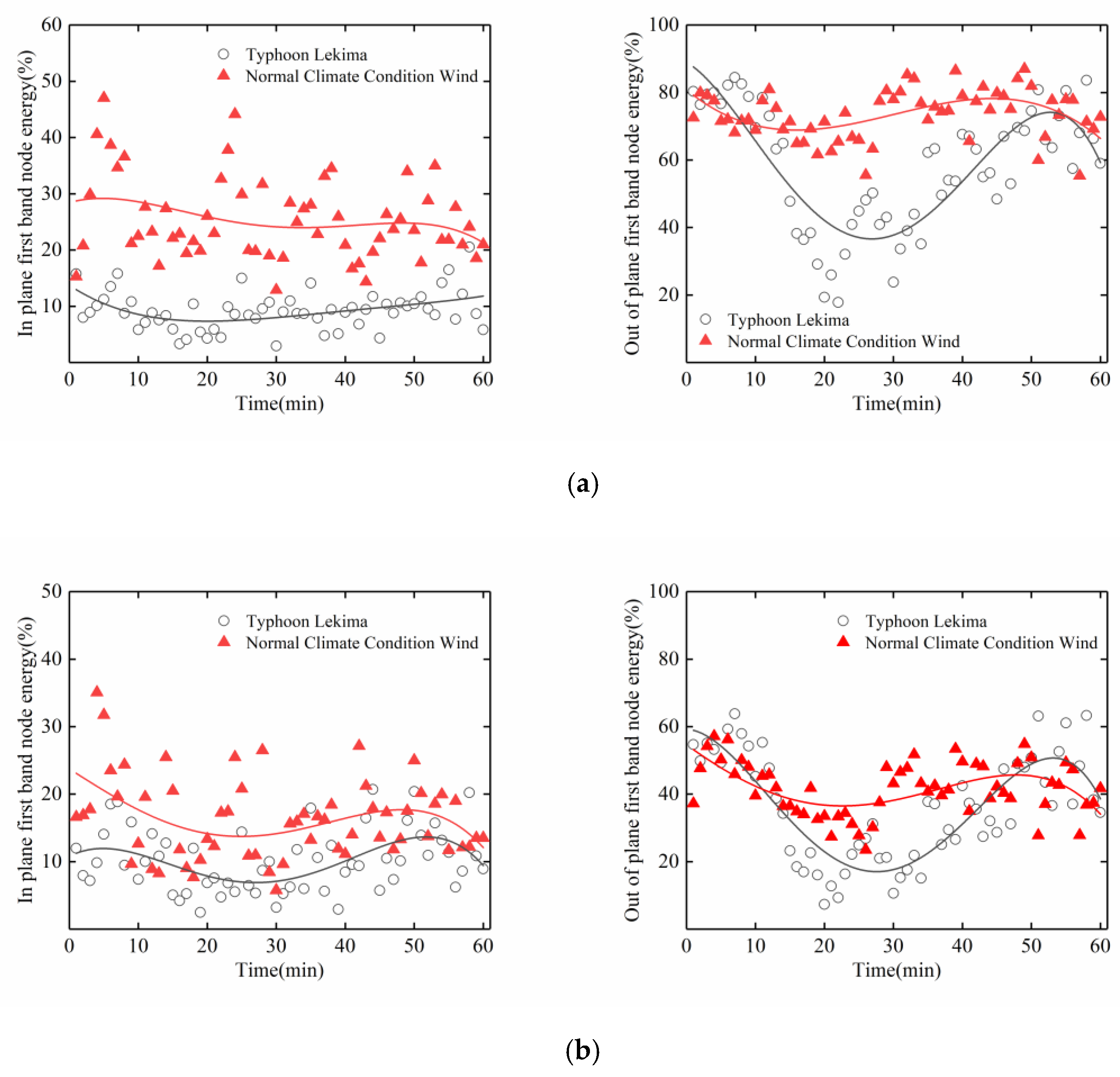
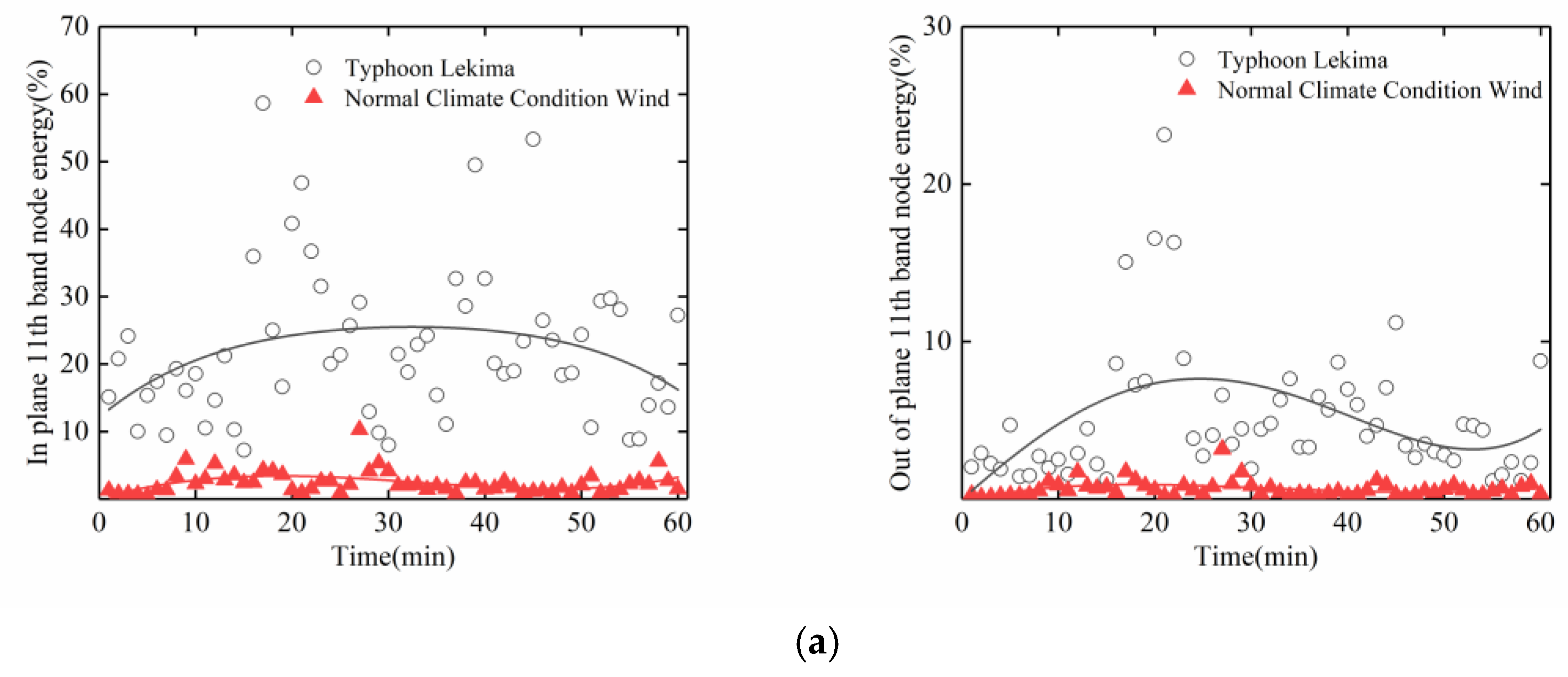
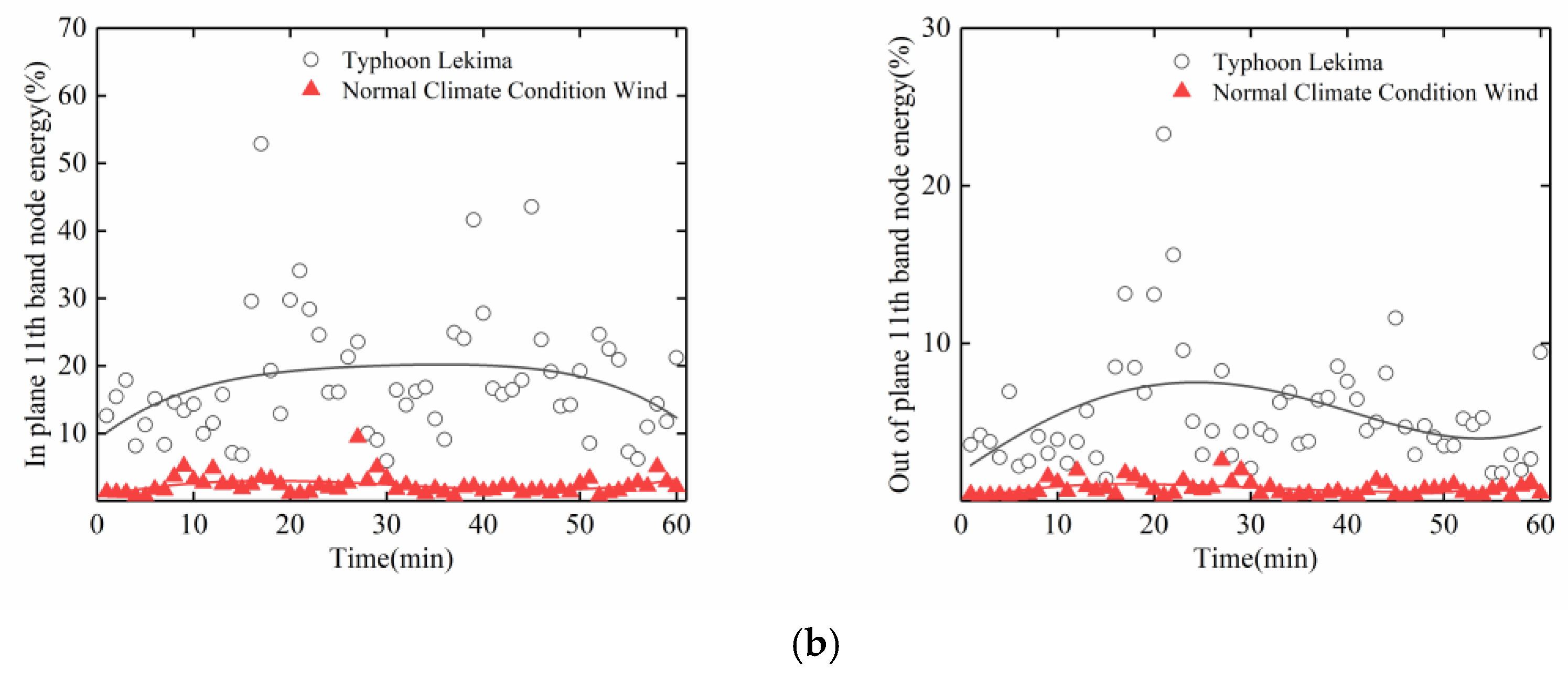
| Project | Technical Standard |
|---|---|
| Number of channels | Single and double |
| Sampling frequency | 200 Hz, adjustable |
| Frequency response | 78 Hz DC |
| Range | 2 g |
| Communication mode | 4G |
| Sampling method | Timing, interval, trigger, continuous acquisition |
| Data storage | Cloud server |
| Work time | Solar energy or 220 V AC, long-term monitoring |
| Work temperature | −10 °C to +80 °C |
| Relative humidity | 20%–85% |
| IP protection level | IR67 |
| IR protection level | IK10 |
© 2020 by the authors. Licensee MDPI, Basel, Switzerland. This article is an open access article distributed under the terms and conditions of the Creative Commons Attribution (CC BY) license (http://creativecommons.org/licenses/by/4.0/).
Share and Cite
Guo, J.; Zhu, X. Field Monitoring and Analysis of the Vibration of Stay Cables under Typhoon Conditions. Sensors 2020, 20, 4520. https://doi.org/10.3390/s20164520
Guo J, Zhu X. Field Monitoring and Analysis of the Vibration of Stay Cables under Typhoon Conditions. Sensors. 2020; 20(16):4520. https://doi.org/10.3390/s20164520
Chicago/Turabian StyleGuo, Jian, and Xujiang Zhu. 2020. "Field Monitoring and Analysis of the Vibration of Stay Cables under Typhoon Conditions" Sensors 20, no. 16: 4520. https://doi.org/10.3390/s20164520
APA StyleGuo, J., & Zhu, X. (2020). Field Monitoring and Analysis of the Vibration of Stay Cables under Typhoon Conditions. Sensors, 20(16), 4520. https://doi.org/10.3390/s20164520





